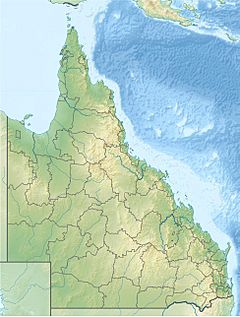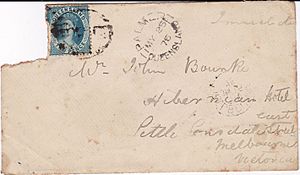Palmer River facts for kids
Quick facts for kids Palmer |
|
|---|---|

A gold mining dredge on the Palmer River.
|
|
|
Location of Palmer River mouth in Queensland
|
|
| Country | Australia |
| State | Queensland |
| Region | Far North Queensland |
| Physical characteristics | |
| Main source | Sussex Range, Great Dividing Range |
| River mouth | confluence with the Mitchell River northeast of Staaten River National Park 64 m (210 ft) 16°04′52″S 142°42′49″E / 16.08111°S 142.71361°E |
| Length | 327 km (203 mi) |
| Basin features | |
| River system | Mitchell River catchment |
| Basin size | 8,335 km2 (3,218 sq mi) |
| Tributaries |
|
The Palmer River is a river in Far North Queensland, Australia. It became famous in the late 1800s because of a huge gold rush that started there in 1873. People came from all over the world hoping to find their fortune!
River's Journey and Features
The Palmer River begins in the Sussex Range, which is part of the Great Dividing Range. This is southwest of Cooktown. The river forms when two smaller streams, Prospect Creek and Campbell Creek, join together. This happens near the Palmer River Roadhouse.
From there, the Palmer River flows west across the Cape York Peninsula. It is joined by 29 smaller streams, called tributaries. Some of these include the South Palmer River and the North Palmer River. Finally, the Palmer River meets the Mitchell River. This meeting point is northeast of Staaten River National Park.
The river drops about 365 metres (1,198 ft) (1,198 feet) along its 327-kilometre (203 mi) (203 miles) journey. The area of land that drains into the Palmer River is called its catchment area. This area is very large, covering about 8,335 square kilometres (3,218 sq mi) (3,218 square miles).
History of the Palmer River Gold Rush
The Palmer River area was once home to the Yalanji Aboriginal people. Their traditional lands stretched from the Mossman River to the Annan River. This included the headwaters of the Palmer River.
The Palmer River became one of Australia's most important gold rush sites. In 1872, a man named William Hann and a geologist named Norman Taylor found gold in the river's sandy bed. Hann named the river after Arthur Hunter Palmer, who was the Premier of Queensland at the time.
The main town for the gold field was Maytown. It started as a camp in 1873 and quickly grew into a town. Maytown became the main center for the area. Other small settlements like Byerstown and Idatown also grew up along the river.
As more settlers arrived, there were some disagreements and clashes with the local Aboriginal people. One famous event was called Battle Camp.
Many different people came to the Palmer River to find gold. A large number of miners were Chinese, mostly from the Guangdong Province in southern China. These Chinese miners often worked the areas that European miners had already left. By 1876, many Chinese miners were working on the Palmer Gold Field. As gold became harder to find, some people started to feel negative towards the Chinese miners.
Today, most of the gold close to the surface has been found. However, there are still a few deeper mining projects in the area.
Images for kids




